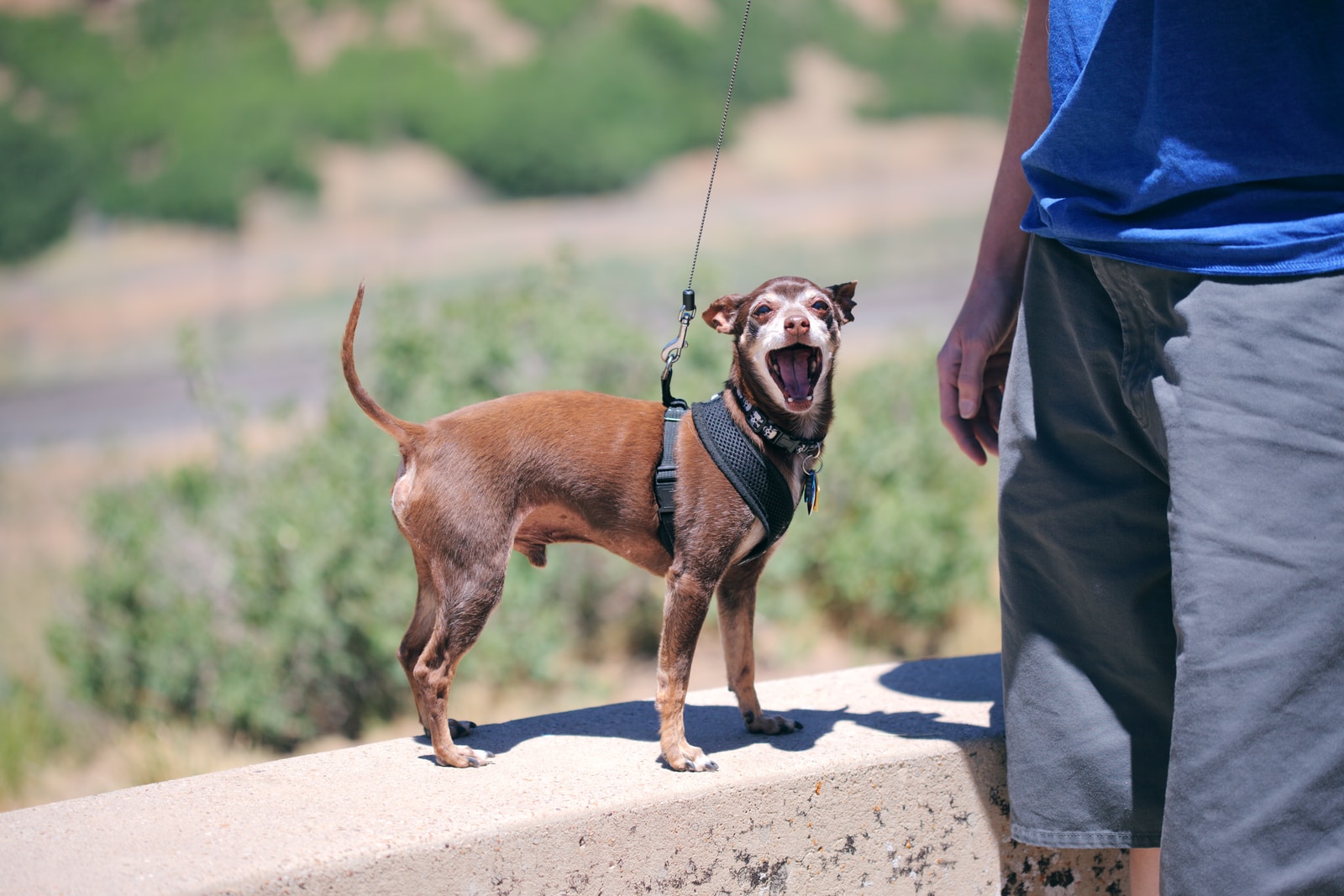The problem of excessive dog barking
Excessive barking is typical among dogs, causing disruption and distress for the pet and its owner. In addition, it can lead to strained relationships with neighbors, sleepless nights, and decreased quality of life for everyone involved.
One potential solution to this problem is using a dog muzzle to stop barking. Muzzles can help control excessive barking safely and humanely while allowing the dog to breathe and drink water.
In this article, we will explore the reasons behind excessive barking in dogs, the role of dog muzzles in stopping this behavior, and how to correctly choose, fit, and use a muzzle for your dog to ensure their safety and well-being.
Understanding Excessive Barking in Dogs
Reasons behind excessive dog barking
Dogs bark for various reasons, including anxiety, boredom, and territorial behavior. In some cases, the excessive barking may result from underlying health issues, such as pain or cognitive decline.
Understanding the root cause of your dog’s barking is essential to determine the best action to address the issue.
Impact of excessive barking on the dog’s well-being and the owner’s quality of life
Excessive barking can have adverse effects on both the dog and its owner.
For the dog, constant barking can cause stress and anxiety, leading to other behavioral issues or health problems.
For the owner, the noise and disruption can cause sleep disturbances, stress, and strained relationships with neighbors.
According to the American Veterinary Medical Association, nuisance barking is one of the most common complaints from dog owners.
In a study by the University of Bristol, approximately one-third of dog owners reported that their dogs barked excessively. This highlights the prevalence of the issue and the need for practical solutions.
The Role of Dog Muzzles in Stopping Barking
What a dog muzzle is, and how can it be used to stop barking
A dog muzzle is a device that fits over the dog’s snout, preventing them from opening its mouth wide enough to bark.
Muzzles are designed to allow the dog to breathe and drink water while wearing the device, making them a safe and humane solution for controlling excessive barking.
Benefits of using a dog muzzle to control excessive barking
Using a muzzle can provide several benefits, including reducing noise and disruption caused by barking, preventing potential property damage from chewing, and allowing owners to work on training and behavior modification without the constant interruption of barking.
Common misconceptions and concerns about using muzzles on dogs
Many people believe that muzzles are cruel or cause distress to the dog. However, when used correctly and for short periods, muzzles can be a safe and effective tool for managing to bark.
It is essential to choose the right type of muzzle and ensure it is correctly fitted to ensure the dog’s comfort and safety.

Choosing the Right Muzzle for Your Dog
Different types of muzzles are available for controlling barking
Various kinds of muzzles are available for controlling barking, including basket, soft, and custom-fitted muzzles.
Each type has its benefits and drawbacks, so it’s essential to carefully consider your dog’s needs and preferences when selecting a muzzle.
How to measure and fit a muzzle for your dog properly
To ensure a proper fit, measure your dog’s snout length and circumference. These measurements will help you select the correct size and type of muzzle.
When fitting the muzzle, ensure it is snug but not too tight. Your dog should be able to open its mouth slightly and comfortably breathe and drink water while wearing the muzzle.
Important considerations when choosing a muzzle
When selecting a muzzle, consider your dog’s breed, size, and temperament. For example, breeds such as brachycephalic (short-nosed) dogs may require specialized muzzles to accommodate their unique facial structure.
Additionally, dogs with aggressive tendencies may need a more secure muzzle to prevent biting or escape.
Introducing Your Dog to the Muzzle
Step-by-step instructions for introducing a dog to wearing a muzzle
- Begin by allowing your dog to sniff and explore the muzzle, rewarding them with treats and praise.
- Gradually increase the duration of time the muzzle is held against the dog’s snout, continuing to provide treats and praise.
- Once your dog is comfortable with the muzzle’s presence, begin securing it, offering rewards and encouragement.
- Increase the time your dog wears the muzzle, ensuring they remain comfortable and relaxed.
- Practice regular, short sessions with the muzzle until your dog can wear it.
Common challenges and how to overcome them
Some dogs may be resistant or anxious when first introduced to a muzzle. However, patience, positive reinforcement, and gradual acclimation can help overcome these challenges.
If your dog struggles with the muzzle, consider consulting a professional dog trainer or behaviorist for additional guidance and support.
Importance of positive reinforcement when introducing a dog to a muzzle
Positive support is crucial when teaching a dog to a muzzle, as it helps create a positive association with the device.
Reward your dog with treats, praise, and affection throughout the acclimation process to ensure they view the muzzle as a positive and non-threatening tool.

Training Your Dog to Stop Barking
Tips for training your dog to stop excessive barking
- Identify the triggers that cause your dog to bark excessively and work on managing or eliminating these triggers.
- Teach your dog the “quiet” command, rewarding them when they stop barking on cue.
- Distract your dog with toys or activities to redirect their energy and focus away from barking.
- Ensure your dog receives adequate exercise and mental stimulation to prevent boredom-related barking.
Positive reinforcement and consistency are vital to training your dog to stop barking. By rewarding desired behaviors and maintaining a consistent training schedule, you can teach your dog to understand and follow your commands.
Environment’s role in preventing excessive barking
Managing your dog’s environment can play a significant role in preventing excessive barking. This may include blocking visual stimuli, such as covering windows or using white noise machines to mask outside noises that trigger barking.
Additionally, providing your dog with a designated “safe space” in your home can help reduce anxiety and promote calm behavior.
Using the Muzzle to Control Excessive Barking
Tips for using the muzzle to control excessive barking
- Only use the muzzle during specific situations or periods when excessive barking is an issue, such as during walks or when guests visit.
- Monitor your dog closely while wearing the muzzle to ensure safety and comfort.
- Gradually increase the duration your dog wears the muzzle while maintaining a positive association with the device.
- Use the muzzle with training and behavior modification techniques to address the underlying causes of excessive barking.
Importance of consistent training and supervision
Consistent training and supervision are crucial when using a muzzle to control excessive barking. Regular training sessions reinforce desired behaviors, while supervision ensures your dog’s safety and comfort while wearing the muzzle.
Potential pitfalls to avoid when using a muzzle for this purpose
- Do not use a muzzle as a long-term or permanent solution for excessive barking. Instead, focus on addressing the underlying causes and implementing behavior modification techniques.
- Avoid leaving your dog unattended while wearing a muzzle, as this can risk their safety.
- Never use a muzzle as a form of punishment, as this can create a negative association and exacerbate existing behavioral issues.
Alternative Solutions for Controlling Excessive Barking
Alternative solutions for controlling excessive barking include professional training, increased exercise, and behavior modification techniques, such as counter-conditioning and desensitization.
Each solution targets the root cause of excessive barking and promotes long-term improvement in your dog’s behavior.
The pros and cons of each solution
- Professional training: Pros include expert guidance and tailored training plans; cons may include the cost and time commitment involved.
- Increased exercise: Pros include improved physical and mental well-being for your dog; cons may consist of the need for additional time and effort from the owner.
- Behavior modification: Pros include long-lasting improvements in behavior; cons may include the need for patience and consistency in training.
Choose a solution that best suits your dog’s needs, considering their age, breed, temperament, and the specific triggers for their excessive barking. Implementing a combination of these solutions may be beneficial for optimal results.
Maintaining Your Dog’s Safety and Well-Being
Check your dog’s behavior and health while using a muzzle
Monitoring your dog’s behavior and health while wearing a muzzle ensures their safety and comfort.
Regularly check for signs of discomfort, such as panting, drooling, or agitation, and adjust the fit of the muzzle or remove it as needed.
Proper care and maintenance of a muzzle
Proper care and maintenance of a muzzle involve regularly cleaning the device with mild soap and water to remove dirt, debris, and bacteria. In addition, inspect the muzzle for signs of wear and tear, and replace it if necessary to ensure your dog’s safety.
Potential risks associated with using a muzzle
The potential risks of using a muzzle include overheating, choking, or injury to the dog’s snout. To minimize these risks, ensure that the muzzle is fitted correctly and allows the dog to breathe and pant comfortably.
Avoid using a muzzle during hot weather or when the dog is at risk of overheating. Always supervise your dog while wearing the muzzle to address any issues that may arise promptly.
Conclusion
Using a dog muzzle to control excessive barking can be an effective and humane solution for managing this disruptive behavior.
When combined with proper training and behavior modification techniques, a muzzle can help improve the dog’s and its owner’s quality of life.

Benefits of using a dog muzzle to stop barking
The benefits of using a muzzle include reduced noise and disruption, increased safety for the dog and others, and the opportunity to work on training and behavior modification without constant barking interruptions.
A muzzle can be a valuable tool in controlling excessive barking by addressing common misconceptions and ensuring proper fit and use.
In conclusion, a dog muzzle can effectively control excessive barking when used correctly and with training and behavior modification techniques.
Choosing the correct type of muzzle for your dog, properly introducing them to the device, and consistently monitoring their safety and well-being while using it are essential.
Addressing the root causes of excessive barking and implementing a comprehensive approach can help your dog enjoy a quieter and more harmonious life.
















